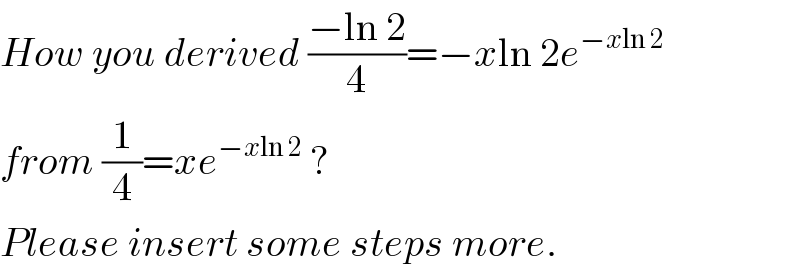
Question Number 5734 by sanusihammed last updated on 25/May/16

$${Please}\:{show}\:{me}\:{an}\:{approach}\:{to}\:{solve}\:{this}... \\ $$$$ \\ $$$$\mathrm{2}^{{x}} \:=\:\mathrm{4}{x} \\ $$$$ \\ $$$${Find}\:{the}\:{value}\:{of}\:{x}\: \\ $$
Answered by prakash jain last updated on 25/May/16

$$\mathrm{2}^{{x}} =\mathrm{4}{x} \\ $$$$\mathrm{1}=\frac{\mathrm{4}{x}}{\mathrm{2}^{{x}} } \\ $$$$\mathrm{1}=\frac{\mathrm{4}{x}}{{e}^{{x}\mathrm{ln}\:\mathrm{2}} }=\mathrm{4}{xe}^{−{x}\mathrm{ln}\:\mathrm{2}} \\ $$$$\frac{\mathrm{1}}{\mathrm{4}}={xe}^{−{x}\mathrm{ln}\:\mathrm{2}} \\ $$$$\frac{−\mathrm{ln}\:\mathrm{2}}{\mathrm{4}}=−{x}\mathrm{ln}\:\mathrm{2}{e}^{−{x}\mathrm{ln}\:\mathrm{2}} \\ $$$${W}\left(−\frac{\mathrm{ln}\:\mathrm{2}}{\mathrm{4}}\right)=−{x}\mathrm{ln}\:\mathrm{2} \\ $$$${x}=−\frac{{W}\left(−\frac{\mathrm{ln}\:\mathrm{2}}{\mathrm{4}}\right)}{\mathrm{ln}\:\mathrm{2}} \\ $$$${W}\:\mathrm{is}\:\mathrm{product}\:\mathrm{logarithm}\:\mathrm{function} \\ $$$${W}\left({xe}^{{x}} \right)={x}\: \\ $$$${S}\mathrm{o}\:{W}\left(−{x}\mathrm{ln}\:\mathrm{2}{e}^{−{x}\mathrm{ln}\:\mathrm{2}} \right)=−{x}\mathrm{ln}\:\mathrm{2} \\ $$
Commented by Yozzii last updated on 26/May/16

Commented by Yozzii last updated on 26/May/16

$${In}\:{case}\:{you}\:{wanted}\:{a}\:{bit}\:{more} \\ $$$${information}\:{on}\:{W}. \\ $$
Commented by Rasheed Soomro last updated on 26/May/16

$${How}\:{you}\:{derived}\:\frac{−\mathrm{ln}\:\mathrm{2}}{\mathrm{4}}=−{x}\mathrm{ln}\:\mathrm{2}{e}^{−{x}\mathrm{ln}\:\mathrm{2}} \\ $$$${from}\:\frac{\mathrm{1}}{\mathrm{4}}={xe}^{−{x}\mathrm{ln}\:\mathrm{2}} \:? \\ $$$${Please}\:{insert}\:{some}\:{steps}\:{more}. \\ $$
Commented by prakash jain last updated on 26/May/16

$$\mathrm{Multiplied}\:\mathrm{both}\:\mathrm{sides}\:\mathrm{by}\:−\mathrm{ln}\:\mathrm{2} \\ $$
Commented by Rasheed Soomro last updated on 26/May/16

$$\mathcal{T}{hank}\mathcal{S}!\:{I}\:{considered}\:−{x}\mathrm{ln}\:\mathrm{2}{e}^{−{x}\mathrm{ln}\:\mathrm{2}} \\ $$$${as}\:−{x}\mathrm{ln}\:\left(\mathrm{2}{e}^{−{x}\mathrm{ln}\:\mathrm{2}} \right).{So}\:{couldn}'{t}\:{understand}. \\ $$
